the place where Paleontology and Paleoanthropology meets Philately
Uruguay
Prehistoric animals, fossils, Charles Darwin on stamps and postmarks of Uruguay
| << previous country | back to index | next country >> |
Contents:
- Country overview
- Philately of Uruguay
- Official stamps of Uruguay related to Paleontology and Paleoanthropology
- Commemorative postmarks of Uruguay related to Paleontology
- Some other postmarks of Uruguay to consider
- References
- Acknowledgements
Uruguay, officially the Oriental Republic of Uruguay, is a country in the southeastern region of South America. Uruguay shares borders with Argentina to its west and southwest and Brazil to its north and northeast; while bordering the Río de la Plata to the south and the Atlantic Ocean to the southeast.
The country covers an area of approximately 176,000 square kilometers and has a population of an estimated 3.51 million, of whom 2 million live in the metropolitan area of its capital and largest city, Montevideo.
Uruguay was inhabited by the Charrúa people for approximately 4000 years before the Portuguese established Colonia del Sacramento, one of the oldest European settlements in the region, in 1680.
Uruguay won its independence between 1811 and 1828, following a four-way struggle between Spain, Portugal, Argentina and Brazil.
It remained subject to foreign influence and intervention throughout the 19th century, with the military playing a recurring role in domestic politics until the late 20th century.
Modern Uruguay is a democratic constitutional republic, with a president who serves as both head of state and head of government. [R1]
The postal services organised by the stagecoach companies, led by Mr. Lapido, issued on 1 October 1856 the so-called Diligencia (stagecoach stamp).
The first regular series of stamps with government approval was issued on 1 July 1859, resembling the second private 'Sol de Montevideo' issue.
Since 1859, many Uruguayan definitive stamp series have been released. Besides different designs, there were additions and changes involving the postal rates, changes in currency were also reflected on the stamps: the silver peso system in 1862. [R2]
Official stamps of Uruguay related to Paleontology: fossil, prehistoric animals, Charles Darwin
| 20.09.1988 "150th anniversary of the Natural History Museum" [1] | 18.04.1996 "Prehistoric animals" | 05.05.1997 "Prehistoric animals" |
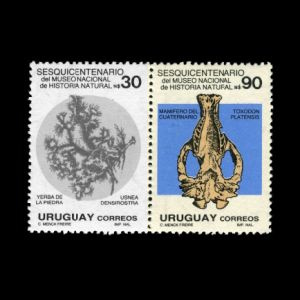 |
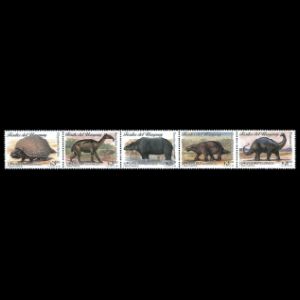 |
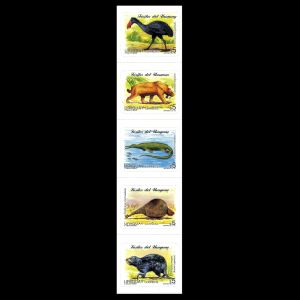 |
| 03.09.1997 "160th anniversary of the Natural History Museum" [2] | 26.03.1998 "Fossils of Uruguay" | 31.08.2009 "Charles Darwin" |
 |
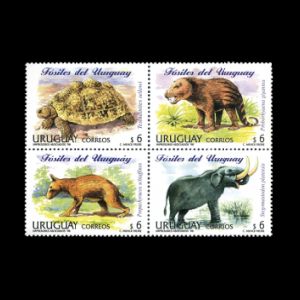 |
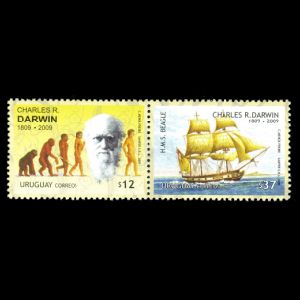 |
Notes:
[1] Fossil of Toxodon's skull shown on the stamp with face value of 90 N$.
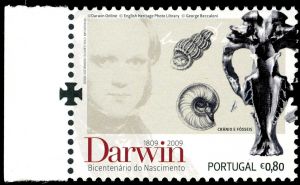
|
| Charles Darwin and fossil of Toxodon's skull on stamp of Portugal 2009, MiNr.: 3388, Scott: 3094 |
Toxodon is an extinct genus of South American mammal from the Late Miocene to early Holocene epochs who lived from 11.6 million to 11,000 years ago.
Charles Darwin (depicted on stamp of Uruguay in 2009) was one of the first to collect Toxodon fossils, after paying 18 pence for a Toxodon platensis skull from a farmer in Uruguay, on the visit the country during his voyage on board the HMS Beagle.
In "The Voyage of the Beagle" Darwin wrote,
"November 26th – I set out on my return in a direct line for Montevideo. Having heard of some giant's bones at a neighbouring farm-house on the Sarandis, a small stream entering the Rio Negro, I rode there accompanied by my host and purchased for the value of eighteen pence the head of the Toxodon."
Since Darwin discovered that the fossils of similar mammals of South America were different from those in Europe, he invoked many debates about the evolution and natural selection of animals. [R5]
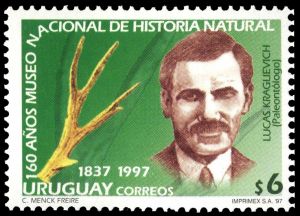
|
| Paleontologist Lucas Kraglievich and antler of prehistoric deer Antifer on stamp of Uruguay 1997, MiNr.: 2281, Scott: 1680a |
He studied engineering at the University of Buenos Aires, Argentina, although he dropped out when he was about to finish it.
A year before his death (1931), he moved to Uruguay, due to political persecution in Argentina, where he developed complex research, based on fossil collection of Natural History Museum in Montevideo and published important treatises on mammals and fossil birds.
He was a pioneer of the paleontological study of vertebrates in Uruguay, making many discoveries in the field. [R3]
The antler on the left side of the stamp is of Antifer - an extinct genus of large herbivorous deer of the family Cervidae, endemic to South America during the Pleistocene, who lived from 2.6 million - 13.000 years ago.
Antifer was named by Florentino Ameghino in 1889, based on Captain Antifer in a Jules Verne novel describing his voyage of discovery in the southern hemisphere.
It was assigned to the family Cervidae in 1988. [R4]
Commemorative postmarks of Uruguay related to Paleontology: fossils
Legend is here| 18.04.1996 "Prehistoric animals" [FDC] | 05.05.1997 "Prehistoric animals" [FDC] | 26.03.1998 "Fossils of Uruguay" [FDC] |
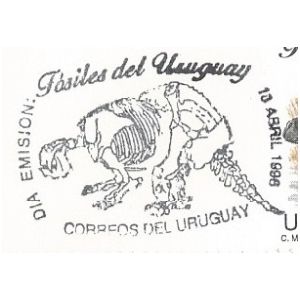 |
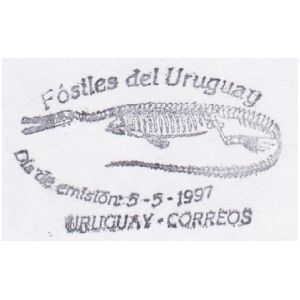 |
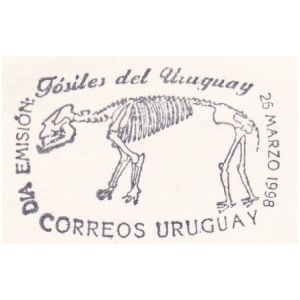 |
Some other commemorative postmarks of Uruguay to consider: home of Charles Darwin
Legend is here| 31.08.2009 "Charles Darwin" [FDC] | ||
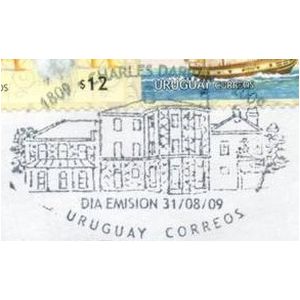 |
|
|
References:
- [R1] Uruguay: Wikipedia, FlagCounter
- [R2] Postal History and Philately of Uruguay:
Wikipedia
Links to official website of the Post Authority, stamp catalog and a list of new stamps of Uruguay are here - [R3] Lucas Kraglievich: Post of Uruguay, Second Wiki,
- [R4] Antifer: Wikipedia
- [R5] Toxodon: Wikipedia, National Geographic,
Acknowledgements:
Many thanks to Dr. Peter Voice from Department of Geological and Environmental Sciences, Western Michigan University, for reviewing the draft page and his valuable comments.
| << previous country | back to index | next country >> |